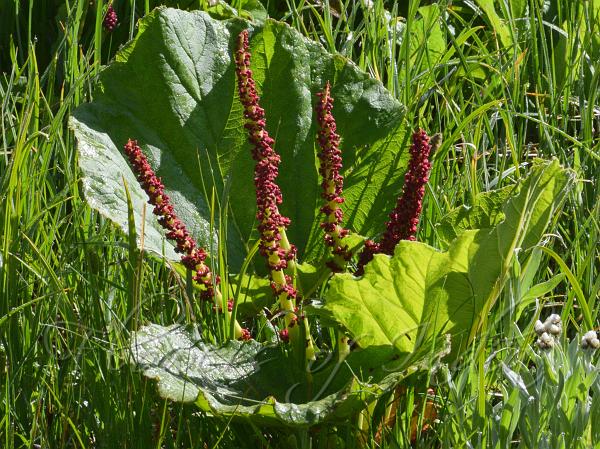|
| West-Himalayan Rhubarb |
|

|

| File size | 1395061 |
| Original date | 7/5/21 8:27 AM |
| Resolution | 3787 x 3174 |
| Flash | Flash did not fire |
| Focal length | 175.0mm |
| Exposure time | 1/200s |
| Aperture | 25.0 |
| Focus Distance | |
| Metering Mode | Multi-segment |
| Camera make | NIKON CORPORATION |
| Camera model | NIKON D5300 |
| Sensor type | OneChipColorArea |
|
|
|
|
Photo: |
Botanical name: Rheum moorcroftianum Family: Polygonaceae (Knotweed family)
West-Himalayan Rhubarb is a dwarf, prostrate stemless
herb, with 3-6 large basal leaves, forming a rosette. Flowers are borne
in spike-like panicle, axis 2-5, nearly equal to leaf. Flower-stalks
are about 2 mm, slender. Tepals are yellow-white or with some red,
narrowly oblong or oblong-elliptic, inner 3 larger, about 2 mm. Anthers
are purple-red. Leaf-stalks are finely striped, short, 3-6 cm,
hairless. Leavesare dark purple below, green above, ovate or triangular
ovate, 6-12 x 4-8.5 cm, below hairless, above hairless, basal veins 5,
leathery, base rounded or slightly heart-shaped, margin entire,
palmately divided to pinnate, tip bluntly pointed. Fruit is ovoid or
broadly ovoid, 7-8 x 5-6 mm; wings narrow, 1-1.5 mm, with longitudinal
veins at middle. West-Himalayan Rhubarb is found in the Himalaya, from
Kumaun to Nepal and Tibet, at altitudes of 3600-4400 m. Flowering:
June-July.
Medicinal uses: It is believed to have some
medicinal properties, like some other Rheum species.
It is believed to have some
medicinal properties, like some other Rheum species.
Medicinal uses:
 It is believed to have some
medicinal properties, like some other Rheum species.
It is believed to have some
medicinal properties, like some other Rheum species. | Identification credit: Sunit Singh, Ashok Meena | Photographed in Nandi Kund, Madhmaheshwar, Uttarakhand. |
• Is this flower misidentified? If yes,